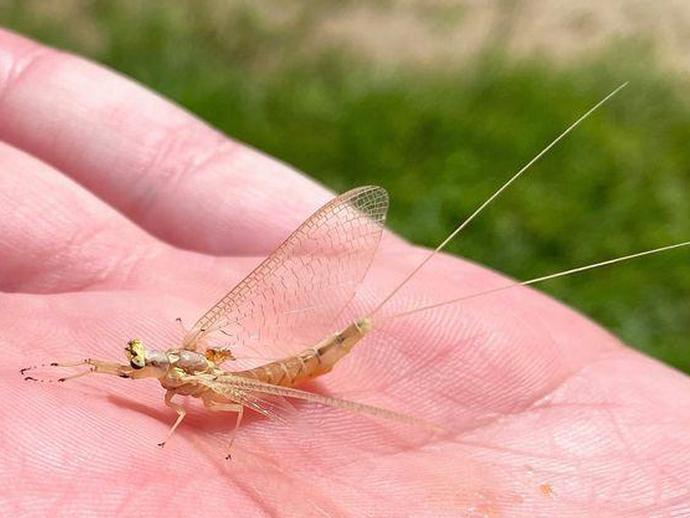November 27, 2021
We're reaching into the archives for today's #BenInNature update presented by our friends at Carter Bank & Trust! The following post was originally published on September 3, 2020.
This mayfly belongs to the genus Hexagenia, also known as the burrower mayflies. They get their common name because while they're in the aquatic nymph stage, they dig little U-shaped tunnels. They hide in the tunnels and wiggle their bodies, which draws water through the tunnel -- and along with it, all kinds of microscopic organisms that they can eat!
Mayflies are truly fascinating insects. Like dragonflies and damselflies, they belong to the ancient division of insects known as Palaeoptera, and they have a number of traits that were likely present in the earliest flying insects on Earth, such as wings that don't fold flat over the abdomen and long tails. Within the division Palaeoptera, mayflies belong to the order Ephemeroptera, which is the only order of insects that molts a second time after developing wings! The initial winged adult is known as the "subimago," while the second winged adult form is known as the "imago." If you're a fly fisherman (or fly fisherwoman), you probably refer to the subimago stage as a "dun."
Mayflies begin appearing in May and continue to emerge from the water throughout the summer, often in absolutely massive numbers (sometimes clouds of mayflies show up on weather radar!). The reason they all tend to emerge at once is tied to the mayfly's most famous trait: their incredibly short lifespans. While adult males can live for as long as two days, the adult females of some species of mayfly die after just five minutes! As a result, mayflies are all about efficiency. After they molt for the last time, they devote all of their energy to mating and laying eggs. They don't have time to eat; in fact, they don't even have mouths! The females are capable of laying a truly vast number of eggs, anywhere from a few hundred to about 3,000 during their short lives.
For centuries, mayflies have captured the imagination. Aristotle mentions them in his "History of Animals," Pliny the Elder wrote about them in his "Natural History," and they're even mentioned in "The Epic of Gilgamesh," one of the earliest surviving works of literature! Mayflies usually serve as a metaphor for something that has a brief (but often spectacular) life.
Of course, mayflies also capture the imaginations of fishing enthusiasts, and there's no better time to go fishing than when a bunch of mayflies have hatched. If you find mayflies at your favorite body of water, consider it a good sign; these little guys are extremely sensitive to pollution.
Thank you to VMNH Executive Director Dr. Joe Keiper for identifying this one for me!
ABOUT #BenInNature
Social distancing can be difficult, but it presents a great opportunity to become reacquainted with nature. In this series of posts, Administrator of Science Ben Williams ventures outdoors to record a snapshot of the unique sights that can be found in the natural world. New updates are posted Monday - Friday, with previous posts highlighted on the weekends. This series of posts is made possible thanks to the support of VMNH Corporate Partner Carter Bank & Trust (www.cbtcares.com).
NATURE PHOTO IDENTIFICATIONS
If you discover something in nature that you would like help identifying, be sure to message us right here on Facebook with a picture (please include location and date of picture) and we'll have our experts help you identify it!

 Hours & Admissions
Hours & Admissions Directions
Directions

